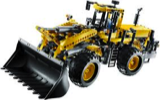
LEGO Technic
LEGO Technic: Advanced Techniques for Advanced LEGO Builders
The concept of LEGO Technics was first introduced in Europe as Technical Set in 1977, and later in the United States as the Expert Builder series with sets such as Car Chasis (853) and Fork Lift Truck (850). Also introduced that year was a Technical Motor (870), a 4.5 volt motor used to turn the special gears of the sets.
LEGO Technics sets have been evolving over the years with the greatest change being in the year 2000 when studless construction techniques were employed (studs are the small circular protrusions on LEGO bricks). Studless beams had been incorporated into LEGO Technic sets for years, but the shift to studless construction was a totally new way of thinking that was and still is controversial.
Components
The components of LEGO Technics are an expansion of the customary LEGO bricks sets, allowing additional functionality and building techniques that were not possible before. The most drastic design change from customary LEGO bricks is that beams have holes through their vertical sides, which are arranged between normal studs. The beams are connected via pins either side-by-side or at various angles.Motors
With the mechanical aspect of Technic emphasized, it was only natural that motors would be a part of the system. Most of the motors are battery powered although some run off of electricity. Early motors looked like a large LEGO brick with an axle off to one side that would rotate and power whatever was necessary.Power Functions
A major change in motor design occurred in 2008 when the Power Functions motor system was introduced. It was basically a remote controlled motor that could be used on new models as well as retrofitted to older models. The move breathed new life into the Technics line, and allowed older models to be retrofitted with remote control functions.Gears
What would motors be without gears to change the speed of the moving parts. LEGO gears come in a variety of sizes and types including worm and differential gears to reduce and/or enhance speeds. An updated version of the differential gear was released in 2008 that was optimized for the new studless construction as discussed above.Notable Developments
In 1977 the LEGO Technical Set was introduced in Europe which still used mainly traditional studded building techniques, but add new pieces such as gears, axles and special beams and plates.For the year 1982 a new concept was unveiled called Universal Building Sets. Prior sets included instructions for at least one alternate design, but the new sets had no real primary design, just a number of instructions for various models. The term Technic was first used this year.
Major developments were introduced in 1990 including a new 9V motor system and the Control Center that could control up to three motors at the same time. Along with these innovations were six new sets including Night Chopper (8825) and Rally 6-Wheeler (8830).
Another important year was 1994 when the 8000 series of Universal Sets and the 8800 series came to an end. There were eight sets released that year including one of the most beloved of all time - the 8880 Super Car. Many consider the 8880 the pinnacle of Technic development to this date, and the year 1994 to be a time of the Golden Age of LEGO.
The release of LEGO Mindstorm occurred in 1998, ushering in the first full programmable LEGO sets. The Robotic Invention System (9719) was the first LEGO Mindstorms which introduced the RCX brick, the heart of the system.
Of course the year 2000 saw the change to studless construction, perhaps the most daring change to LEGO Technic to date.